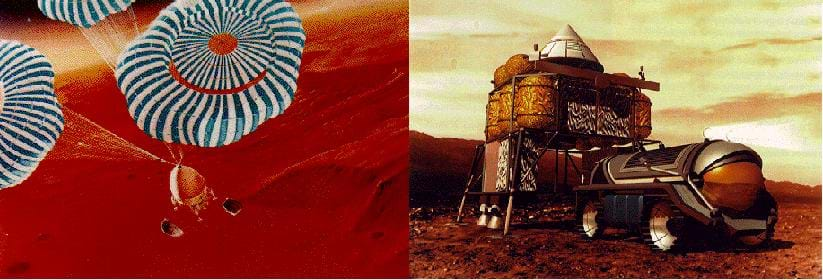
Summary
The Mission to Mars unit introduces students to Mars, often called the Red Planet. Students discover why everyone is so interested in studying this mysterious planet. Many interesting facts about Mars are revealed, and the history of Martian exploration is reviewed. Students learn about the development of robotics and how robots are beneficial to science, society and the exploration of space. Details on engineers' involvement in space exploration are explained, such as how orbits enable astronauts to move from planet to planet and what type of equipment is used by scientists and engineers to safely explore space. The specific details on and human risks for a possible future "humanned" mission to Mars (and back to Earth again!) are explored.Engineering Connection
Engineers have played various roles in the long history of exploring the Red Planet. In the mid-20th century, engineers designed rockets and probes that provided the first, up-close visuals of the mysterious planet. And, aerospace and electrical engineers designed and fabricated surface exploration equipment so that we could explore the planet in person! Today, engineers continue to work with scientists to develop reliable orbiters, rovers, aircraft and human transport for future missions.
Engineers know that risks are always involved with the exploration of space—just as in our daily lives. But for optimum human health and safety, engineers do their best to minimize risks by extensive testing and smart design of transportation, appliances, equipment and products. Engineers make our exploration of space possible and safe!
Educational Standards
Each TeachEngineering lesson or activity is correlated to one or more K-12 science,
technology, engineering or math (STEM) educational standards.
All 100,000+ K-12 STEM standards covered in TeachEngineering are collected, maintained and packaged by the Achievement Standards Network (ASN),
a project of D2L (www.achievementstandards.org).
In the ASN, standards are hierarchically structured: first by source; e.g., by state; within source by type; e.g., science or mathematics;
within type by subtype, then by grade, etc.
Each TeachEngineering lesson or activity is correlated to one or more K-12 science, technology, engineering or math (STEM) educational standards.
All 100,000+ K-12 STEM standards covered in TeachEngineering are collected, maintained and packaged by the Achievement Standards Network (ASN), a project of D2L (www.achievementstandards.org).
In the ASN, standards are hierarchically structured: first by source; e.g., by state; within source by type; e.g., science or mathematics; within type by subtype, then by grade, etc.
See individual lessons and activities for standards alignment.
Subscribe
Get the inside scoop on all things TeachEngineering such as new site features, curriculum updates, video releases, and more by signing up for our newsletter!Unit Schedule
- Day 1: The Amazing Red Planet lesson
- Day 2: An Inflated Impression of Mars activity
- Day 3: Red Rover Robotics lesson
- Day 4: Strong-Arm Tactics activity
- Day 5: Come On Over Rover lesson
- Day 6-8: Edible Rovers activity or Edible Rovers – High School activity
- Day 9: Get Me Off This Planet lesson
- Day 10: The Great Gravity Escape activity
- Day 11: Six Minutes of Terror lesson
- Day 12: Egg-cellent Landing activity
- Day 13: Manned Mission to Mars lesson
- Day 14: Are We Alone? activity
More Curriculum Like This

Students are introduced to the planet Mars. They begin by discussing the location and size of Mars relative to Earth, as well many interesting facts about this "red planet." Next, the history of Martian exploration is reviewed and students discover why researchers are so interested in studying this ...

Students learn about the human safety risks that are evaluated and addressed to minimize danger to astronauts. They examine a specialized launch schedule and the varied backgrounds and professions of the crew. Students find out about the crew's activities and living conditions once on the Martian su...

During this lesson, students discover the journey that a Mars rover embarks upon after being designed by engineers and before being prepared for launch. Students investigate the fabrication techniques, tolerance concepts, assembly and field-testing associated with a Mars exploratory rover.

Students explore Mars and Jupiter, the fourth and fifth planets from the Sun. They learn some of the unique characteristics of these planets.
Copyright
© 2009 by Regents of the University of ColoradoContributors
See individual lessons and activities.Supporting Program
Integrated Teaching and Learning Program, College of Engineering, University of Colorado BoulderAcknowledgements
The contents of these digital library curricula were developed under grants from the Fund for the Improvement of Postsecondary Education (FIPSE), U.S. Department of Education, and the National Science Foundation (GK-12 grant no. 0338326). However, these contents do not necessarily represent the policies of the U.S. Department of Education or National Science Foundation, and you should not assume endorsement by the federal government.
Last modified: August 7, 2017







User Comments & Tips